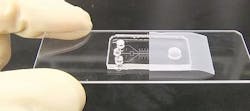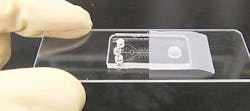Fluorescence-producing, self-powered microfluidic chip detects cancer fast
Researchers at the RIKEN Advanced Science Institute (Wako, Japan) have developed a self-powered microfluidic chip that can perform an analysis for cancer-specific microRNAs in a drop of patient blood in as little as 20 minutes. Claimed as the most sensitive microRNA detector yet, if enough of the target is present, the chip produces a fluorescence signal that can be detected using a fluorescence microscope.
Early detection is vital for the effective treatment of cancer. In many cases, tell-tale biomarkers are present in the bloodstream long before outward symptoms become apparent. Early-stage cancers, for example, release tiny quantities of biomolecules called microRNAs into the blood. The development of an inexpensive and rapid point-of-care diagnostic test capable of spotting such early biomarkers of disease could therefore save many lives.
The test developed by Kazuo Hosokawa and colleagues at Riken is inexpensive to make and relies on an internal pressure gradient to pump the sample through the microchannels, thus eliminating the need for an external power supplyâfeatures that make the system highly suitable for practical point-of-care disease diagnosis. Previous versions of the chip, however, could only detect microRNA at concentrations far above those required for early cancer detection.
In their latest work, Hosokawa and co-workers increased the chip's sensitivity by boosting the intensity of fluorescence generated by a positive test. The original chip worked by immobilizing target microRNA on probe DNA in the main microchannel, where each bound site produced a fluorescent signal. In the new chips, the researchers added a fluorescence amplification process that involves passing two amplification reagents over the immobilized microRNA. The reagentsâa fluorescent tag and a branched linkerâbind to immobilized microRNA to form tree-like dendritic structures that amplify the fluorescence signal by up to 1,000 times. Using this amplification process, the researchers were able to improve the sensitivity of the device to a level approaching that required for early cancer detection.
The next step for the team will be to further simplify the device by eliminating the need for a fluorescence microscope, which will involve replacing the fluorescent tags with some other form of marker. "That is a very important direction for future development," says Hosokawa. "We are planning the use of different labelling materials instead of the fluorescent dye, such as gold particles, which would enable naked-eye detection."
Their work appears in the journal PLoS One; for more information, please visit http://www.plosone.org/article/info%3Adoi%2F10.1371%2Fjournal.pone.0048329.
-----
Follow us on Twitter, 'like' us on Facebook, and join our group on LinkedIn
Subscribe now to BioOptics World magazine; it's free!

